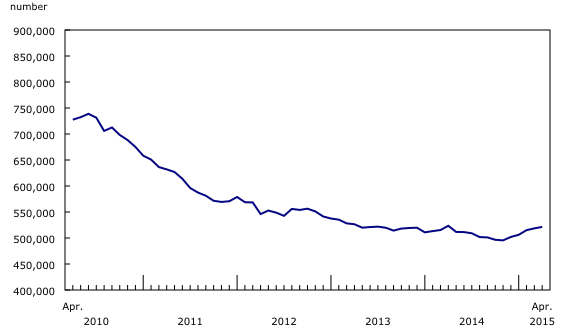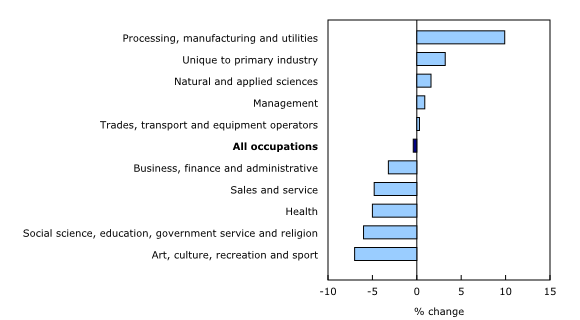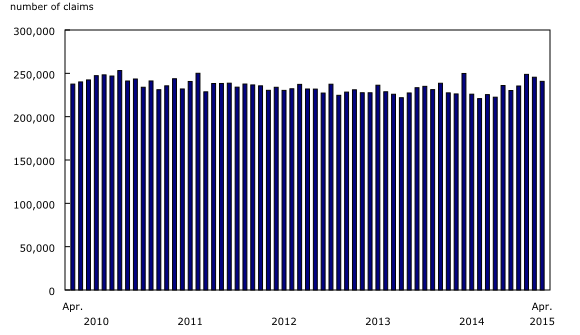Employment Insurance, April 2015
Archived Content
Information identified as archived is provided for reference, research or recordkeeping purposes. It is not subject to the Government of Canada Web Standards and has not been altered or updated since it was archived. Please "contact us" to request a format other than those available.
Released: 2015-06-18
There were 521,300 people receiving regular Employment Insurance (EI) benefits in April, little changed from March (+0.5%) and compared with 12 months earlier (-0.4%).
For the fourth month in a row, Alberta led all provinces in terms of growth in the number of beneficiaries, with a 10.7% increase in April. British Columbia also posted a notable increase (+2.4%), while the number of beneficiaries in Saskatchewan rose slightly. In contrast, the number of beneficiaries fell in Prince Edward Island (-3.5%), and also declined slightly in Newfoundland and Labrador, Manitoba and New Brunswick.
The change in the number of regular EI beneficiaries reflects various situations, including people becoming beneficiaries, people going back to work and people no longer receiving regular benefits.
Provincial and metropolitan area overview
The number of regular EI beneficiaries in Alberta rose for the sixth consecutive month in April, up 10.7% to 43,900. Since October 2014, the number of beneficiaries has increased by 14,600 (+49.6%). Compared with March, the number of beneficiaries increased the most for those in Alberta whose last occupation was in processing, manufacturing and utilities (+23.6%). There were also more beneficiaries among those who last worked in natural and applied sciences (+15.1%).
The number of beneficiaries in April rose for the sixth consecutive month in Edmonton (+10.4%) and Calgary (+9.3%). In the rest of Alberta, the increase was 12.2% compared with March.
British Columbia also saw an increase in the number of people receiving benefits (+2.4%), especially in the province's census agglomerations (CAs), where the increase was 3.8%, as well as in the census metropolitan areas (CMAs) of Kelowna (+3.2%) and Abbotsford–Mission (+2.9%).
The number of beneficiaries in Saskatchewan edged up 1.1%, driven by a 5.2% increase in the province's CAs.
There were fewer people receiving benefits in Prince Edward Island (-3.5%) in April, the first notable monthly decrease since September 2014. The largest decline in April was in the CAs of Charlottetown and Summerside (-5.0% overall).
The number of beneficiaries edged down 1.6% in Newfoundland and Labrador, with a decline of 3.6% in St. John's.
Manitoba (-1.1%) and New Brunswick (-1.0%) also had slightly fewer beneficiaries. In Manitoba, there was a notable decline in the CMA of Winnipeg (-2.6%).
For New Brunswick, the number of beneficiaries decreased in the CAs as well as outside of the CMAs and CAs, while it rose in the metropolitan area of Saint John (+2.7%).
While Quebec posted little change in April, there was a 4.0% increase in the metropolitan area of Trois-Rivières. At the same time, the number of EI beneficiaries fell 2.0% in the province's CAs.
Ontario also saw little change in the number of beneficiaries in April compared with March. However, among the province's 15 metropolitan areas, Oshawa (+20.4%) and Windsor (+10.5%) posted notable increases.
Regular Employment Insurance beneficiaries by occupation
Compared with April 2014, the number of EI beneficiaries in April 2015 was virtually unchanged.
Looking at EI recipients' last occupation, there was a large increase for those whose last job was in processing, manufacturing and utilities (+9.9%) compared with 12 months earlier.
On the other hand, there were fewer beneficiaries in other occupations, mainly for those whose last job was in art, culture, recreation and sport (-7.0%) as well as in social science, education, government service and religion (-6.0%).
Employment Insurance beneficiaries in major demographic groups
From March to April, the number of beneficiaries among men aged 15 to 24 rose 2.9%. There was little change for most other demographic groups.
On a year-over-year basis, the number of beneficiaries decreased for women aged 25 to 54 (-4.0%) as well as for those 15 to 24 (-3.1%). In contrast, both women (+2.0%) and men (+1.7%) aged 55 and older experienced increases.
Employment Insurance claims
The number of EI claims in April declined 1.9% compared with March. The number of claims provides an indication of the number of people who could become beneficiaries.
Provincially, claims declined in Prince Edward Island (-13.5%), Alberta (-8.8%) and Saskatchewan (-4.8%). There were also fewer EI claims in British Columbia (-2.8%), Newfoundland and Labrador (-2.5%) as well as in New Brunswick (-2.4%).
In contrast, the number of claims rose in Nova Scotia (+3.6%) and Manitoba (+3.2%), while there was little or no change in Quebec and Ontario, respectively.
Note to readers
Regular Employment Insurance (EI) benefits are available to eligible individuals who lose their jobs and who are available for and able to work, but cannot find a job. To receive EI benefits, individuals must first submit a claim. The number of claims provides an indication of the number of people who could become beneficiaries.
There is always a certain proportion of unemployed people who do not qualify for benefits. Some unemployed people have not contributed to the program because they have not worked in the past 12 months or their employment is not insured. Other unemployed people have contributed to the program but do not meet the eligibility criteria, such as workers who left their job voluntarily or those who did not accumulate enough hours of work to receive benefits.
All data in this release are seasonally adjusted. For more information on seasonal adjustment, see Seasonally adjusted data – Frequently asked questions.
EI statistics are produced from administrative data sources provided by Service Canada and Employment and Social Development Canada. These statistics may, from time to time, be affected by changes to the Employment Insurance Act or administrative procedures.
The number of regular EI beneficiaries and the number of claims received for the current and previous month are subject to revision.
The number of beneficiaries is a measure of all people who received EI benefits from April 12 to 18. This period coincides with the reference week of the Labour Force Survey (LFS). However, initial and renewal claims data are for the entire month.
EI statistics indicate the number of people who received EI benefits, and should not be confused with LFS data, which provide information on the total number of unemployed people.
Geographical definitions
A census metropolitan area (CMA) or a census agglomeration (CA) is formed by one or more adjacent municipalities centred on a population centre. A CMA, also referred to as a 'metropolitan area' in this release, must have a total population of at least 100,000. A CA must have a population of at least 10,000. See Standard Geographical Classification 2011 – Definitions for more information.
Products
Data on Employment Insurance for May will be released on July 23.
Contact information
For more information, contact us (toll-free 1-800-263-1136; 514-283-8300; infostats@statcan.gc.ca).
To enquire about the concepts, methods or data quality of this release, contact Vincent Ferrao (613-951-4750; vincent.ferrao@statcan.gc.ca), Labour Statistics Division.
- Date modified:






